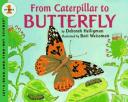Introduction
This topic introduces second graders to the exciting changes that can occur in a butterfly and frog’s life cycles. Through numerous activities children are guided through the process known as Metamorphosis and given the opportunity to become engaged with the material. They are able to learn about and physically see how frogs and butterflies undergo these transformations as they mature and grow in their environments (VA Science SOL 2.4). The material encourages them to interact with the content and in doing so provides them with a better understanding of the content knowledge.
Text Annotations
- Butterflies and Moths by Nic Bishop
 Nic Bishop’s non-fiction narrative provides readers with a realistic visual aide into the stages of butterfly metamorphosis. He helps children understand the transformations a caterpillar undergoes to becoming a butterfly. It is an interactive, hands on book that parents can use to explore the realms of animal life cycles.
Nic Bishop’s non-fiction narrative provides readers with a realistic visual aide into the stages of butterfly metamorphosis. He helps children understand the transformations a caterpillar undergoes to becoming a butterfly. It is an interactive, hands on book that parents can use to explore the realms of animal life cycles. - From Caterpillar to Butterfly by Deborah Heiligman
 This book dives into the stages of butterfly metamorphosis from a child’s perspective by asking the question, ” Where did the caterpillar go?” Heiligman creatively takes her readers through the transformation processes by asking and answering commonly asked children’s questions.
This book dives into the stages of butterfly metamorphosis from a child’s perspective by asking the question, ” Where did the caterpillar go?” Heiligman creatively takes her readers through the transformation processes by asking and answering commonly asked children’s questions. - From Tadpole to Frog by Wendy Pfeffer
 This book uses attractive artwork to describe the two-year life cycle of the American Bullfrog. As a Stage One book “From Tadpole to Frog” it uses simple sentences and concepts that are appropriate for toddlers, preschoolers, and young children up to about 8 or 9 years of age.
This book uses attractive artwork to describe the two-year life cycle of the American Bullfrog. As a Stage One book “From Tadpole to Frog” it uses simple sentences and concepts that are appropriate for toddlers, preschoolers, and young children up to about 8 or 9 years of age. - Frogs by Nic Bishop
 Bishop uses captivating close up photographs of his characters to entice children into the wonders of a frog’s life cycle. But his book takes children beyond the visual perspective of metamorphosis as he provides his readers with a detailed description about how he went about capturing the photographs. This book leaves children longing for more.
Bishop uses captivating close up photographs of his characters to entice children into the wonders of a frog’s life cycle. But his book takes children beyond the visual perspective of metamorphosis as he provides his readers with a detailed description about how he went about capturing the photographs. This book leaves children longing for more. - My, Oh My– A Butterfly! All about Butterflies by Tish Rabe
 You can not go wrong with any Cat in the Hat book, but this Butterfly book is excellent. It keeps kids engaged and excited about the life cycle of a butterfly. It is a great read for young children. Who wouldn’t want to learn about the butterfly life cycle after reading this book.
You can not go wrong with any Cat in the Hat book, but this Butterfly book is excellent. It keeps kids engaged and excited about the life cycle of a butterfly. It is a great read for young children. Who wouldn’t want to learn about the butterfly life cycle after reading this book.
Web Annotations
- The life cycle of a frog– This website presents children with a guided tutorial through a frog’s life cycle. It encompasses an auditory step by step explanation of each stage in the cycle along with a visual representation of each stage, and so entices children to want learn the content. Children can learn this exciting content and have fun doing it.
- Animal life-cycles- This interactive game asks children to organize the pictures on the screen by dragging and dropping them into the correct order sequence for each animallife cycle. Once a child has dragged a picture into the box a detailed description of the stage appears to help them understand what is happening. If they correctly place the butterfly pictures in order they move onto a frog, a flower and then a tree’s cycle. They are rewarded for learning the life cycle sequences with more exciting information.
- Butterfly crossword- When a child clicks on a cross word box a question appears. The child has to type in the correct answer that fits into the box. This activity allows a child to apply all the information they have learnt about a butterfly into a fun and interactive activity.
- Fantastic Frog- This game asks children 10 general knowledge multiple choice questions about frogs. By asking questions like, “What is the name of the biggest frog,” this website teaches children that learning can be both fun and rewarding. It changes the way the children perceive having knowledge as they can now pass on the fun facts they have learnt about frogs.
- Incomplete and complete metamorphosis- By clicking on the butterfly icon on the screen children can watch a movie describing a butterfly’s life-cycle. The movie goes through a step by step process of the different stages in the life-cycle providing it viewers with real life pictures of each process.
Additional Resources for Teachers
- Life processes and living things– This website provides teachers with a wealth of material on life processes. From worksheets to powerpoints this website has it all. It doesn’t matter what type of learners your children are because after being involved with the resources that this website has to offer they will know and love the content.
- Butterfly life cycle activity in the classroom– This website provides teachers with three step by step craft instructions. It provides teachers with fun and interactive activities and crafts that will allow their children to grasp the content of a butterfly life cycle but explore their creative sides as they do it.
- Exploring Butterflies– This website provides teachers with butterfly lesson plans, print outs on the life cycle of the butterfly for children to fill in and writing activities that will allow the children to have fun as they learn the process of metamorphosis. The range of activities offered encourage all children, regardless of their learning styles to jump in and have fun with the material.
- Animal Lifecycle lesson plan– This lesson plan helps children compare and contrast the life cycles on different animals ( one being a frog). Groups of children are asked to analyze and observe the animals stages of development by watching them grow in an aquarium.
- Life cycles of frogs, dragon flies and dragon flies– This lesson plan allows children to become fully integrated in the stages of metamorphosis. Children are exposed to the differences and similarities of various animal life cycles as they observe the development and maturation processes of insects and frogs. Students are engage in reading, video and hands on activities that allows them to grasp the content on animal life cycles.
